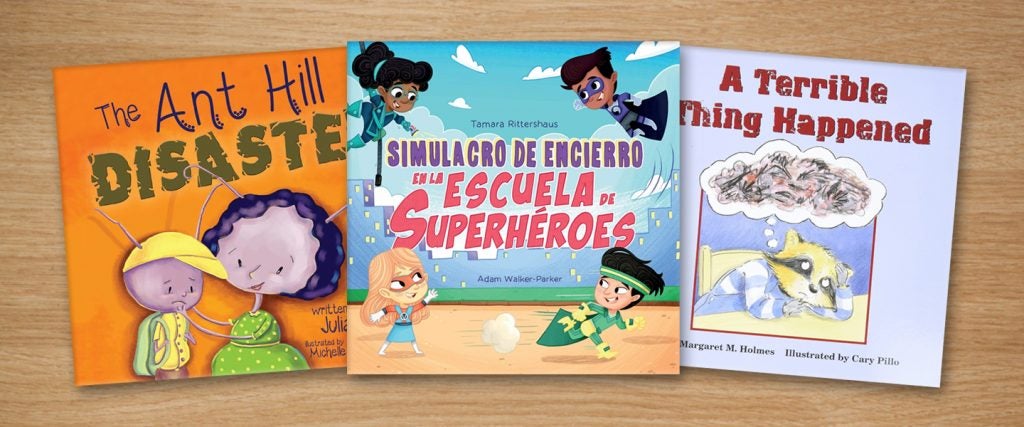I was nine years old when the 1999 Columbine school shooting shocked and horrified the country. And while I clearly remember where I was that day, the events afterward are a bit murkier. That’s likely because there was never any discussion of what should be done at my school if we ever encountered an active shooter or other intruder. And though we continued as usual with our fire and earthquake drills, I left elementary school without ever talking about school shootings again.
There have been at least 554 school shootings since Columbine, with 27 so far this year alone. And in some districts, active shooter drills and practice lockdowns are about as common as the pledge of allegiance. It’s a tragic reality, and perhaps nowhere is it more clearly and literally illustrated than in the educational picture books meant to help young students — many of whom aren’t even old enough to read — know what to do if a strange man enters their classroom and tries to kill them.
In one such book, a cover features cartoon characters of little kids, depicted as if part of a Charlie Brown comic strip — smiling faces, colorful clothes. A boy wearing a hat and a girl with a pink bow in her hair. But unlike Peanuts, Intrude Drills at School: A Social Story is designed to help teachers explain to students young enough to wear such bows in their hair how to barricade themselves with desks and not make a sound as an intruder enters their schools.
“The story begins by discussing lots of ways that students practice safety at school (from washing hands to facing forward in the halls) to start the discussion of safety in a simple way,” per the description on TeachersPayTeachers.com. “Students will learn what an intruder is, what to do during an intruder drill, the importance of listening to adults, remaining calm and quiet, the options of barricading (staying in the classroom) or leaving the school.”
Author Julia Cook has a reputation for writing about topics most children’s book writers won’t touch. In her 2014 book, I’m Not Scared… I’m Prepared!, she uses cartoon ants to communicate what children should do if a “wolf” comes into their classroom: “We MUST stay out of his way!” The book is meant to supplement the A.L.I.C.E. school safety program created in 2000 to help students and their teachers deal with an armed intruder. As one person writes in their review of the book, “It helps children to understand why we need to be proactive and prepared in case the worst ever could happen.”
In Tamara Rittershaus’ Lockdown Drill at Superschool, cartoons recall slightly more realistic kid titans who must learn to lockdown in case a villain or “fire-breathing dragon” lurks behind the classroom door. With headbands and masks, the superhero kids project an eerie level of enthusiasm for the task at hand. Like Cooks’ picture book, Rittershaus’ guide is also meant to supplement the A.L.I.C.E. program.
Though there are plenty of teaching materials designed to mitigate the potential violence before a school shooting, the vast majority of books available are focused on dealing with trauma and aftermath of school shootings and related events. For example, A Terrible Thing Happened: A Story for Children Who Have Witnessed Violence or Trauma is about a raccoon named Sherman Smith who “saw the most terrible thing happen.”
Similarly, Cook’s The Ant Hill Disaster tells the story of a little boy ant who’s afraid to go back to school after the Ant Hill School is destroyed. The themes are similar to Cook’s aforementioned book on how to always be prepared, but the imagery of this book, illustrated by Michelle Hazelwood, is slightly more surreal.
In one part, the mom ant explains to her son that although she’s scared too, “everyone is working together very hard to keep that from happening again.” It’s a nice enough notion for a children’s book, but a little hard to swallow now, considering it’s been nearly eight years since the book was published and we’ve had 51 school shootings with 94 casualties since.
Taken together, these picture books do have a lot to say about what it’s actually like to grow up in a post-Columbine America. It looks like bright, happy cartoons trying to make sense of horrific violence; like educators desperate to give young children a sense of ease and control in the most extreme situations. It looks like doodled speech bubbles meant to convince second graders that they have some control over their survival in the worst imaginable scenario — when, of course, they don’t. But they’ll keep flipping pages and hiding behind desks because the adults who do have already passed the buck.

